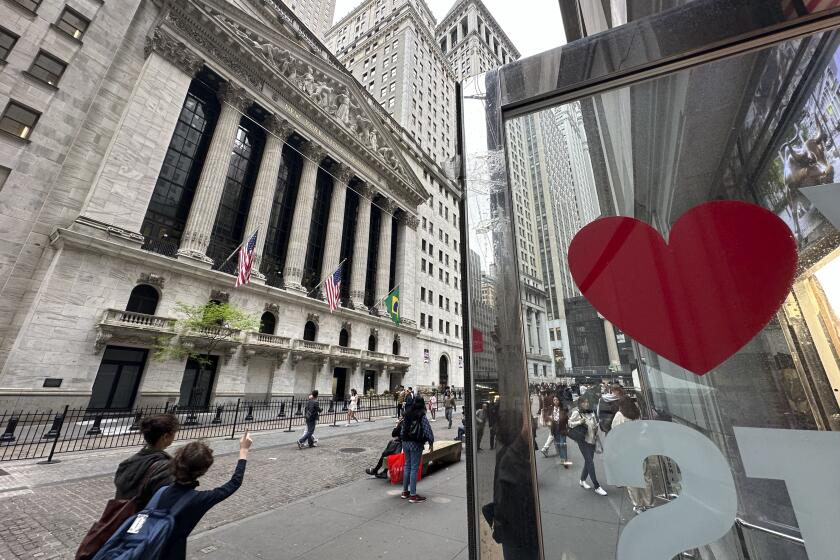Pizza Coming With Delivery Fees on Top
Free pizza delivery, long taken for granted by many Americans, is rapidly becoming a thing of the past.
To offset slowing revenue growth and soaring labor, utility and other operating costs, Pizza Hut, Papa John’s International Inc. and even Domino’s Pizza Inc., the pioneer of free delivery, are increasingly tacking on delivery fees of up to $1.50 in selected markets, including Los Angeles, San Diego and Orange counties. Some experts think that it will soon be standard practice nationwide.
The companies say consumer opposition has been limited. But drivers complain they receive only a portion of the so-called delivery fees and that their tips have plummeted since their introduction. They argue that it would be far more honest to simply raise prices across the board so customers wouldn’t mistakenly believe drivers are profiting from new charges.
“I’m really upset about this,” said Rick, 23, a part-time driver for Domino’s in West Los Angeles who asked that his last name not be used. He said his gratuities have fallen by 25% in recent months. “I don’t know if I’d work for them ever again.”
With the pizza business among the most cutthroat in the entire restaurant industry, chains “can’t raise prices. They’re stuck,” said Christopher Muller, a professor of restaurant management at the University of Central Florida in Orlando. That’s why they are resorting to “hidden price increases,” he said, which are more palatable to consumers and can allow the chains to continue offering such promotions as $9.99 for a large pizza.
Last year, pizza sales grew at a paltry 2.5% to $24.9 billion, registering slower growth than even the sagging burger business. Between 1996 and 2001, pizza revenue increased by an average of just 3.4% per year, compared with 4.7% for the entire fast-food sector, said Dennis Lombardi of Technomic Inc., a restaurant research and consulting firm in Chicago.
None of the major pizza chains has as yet rolled out delivery fees at all restaurants. However, plagued by margin-killing price wars and slow growth, they are expected to do so within two to three years, said Jeremy White, executive editor of Pizza Today, a trade publication.
“Pizza operators have to make their money somewhere,” he said.
But Beverly Hills restaurant consultant Larry Sarokin said the chains risk alienating some customers.
“When you’re used to getting something for free for 25 years and suddenly you have to pay for it, you might not be too happy,” he said.
Pizza Hut, the nation’s biggest pizza company with 8,000 units in the U.S., was the first of the three major pizza chains to charge delivery fees at many outlets. After testing the concept for a year and a half, the Dallas-based subsidiary of Yum Brands Inc. last summer started requiring customers to pay an average of 50 cents to 75 cents at almost all company-owned stores. About 30% of Pizza Hut’s domestic restaurants are owned by the firm.
Consumers consider the fees “no big deal and worth it for the convenience,” Pizza Hut spokeswoman Patty Sullivan said.
Papa John’s, based in Louisville, Ky., also is experimenting with delivery fees. About 15% to 20% of franchise operators now charge them, up from 7% last year.
After much “soul-searching,” Ann Arbor, Mich.-based Domino’s broke with its past and began charging fees at 100 company stores in November and has since expanded the practice to 200 more outlets, spokesman Tim McIntyre said. Forty San Diego franchised stores also charge fees. The 7,096-unit chain expects to make a final decision on the charges by year’s end.
At a time when pizza chains are embracing delivery charges, several Internet retailers are trying to drum up business by eliminating or reducing shipping fees, said Priya Raghubir, a professor of marketing at the Haas School of Business at UC Berkeley. Best Buy Co., for instance, has just begun offering free ground shipping on all orders.
The pizza giants say delivery charges have generated little public outcry.
However, Domino’s driver Mike said more than 30 customers have complained since the Los Angeles Domino’s operator for whom he works slapped on fees two months ago. And frustrated consumers appear to be taking their anger out on him, he said.
In the last eight weeks, Mike, 32, a six-year Domino’s driver who asked that his last name not be used, said his gratuities have plunged by about 50%. About a dozen customers have stiffed him because of their opposition to the fees, he said. Others have tipped him less because they mistakenly believe he pockets the entire charge.
Although Domino’s and other pizza chains pay drivers a small fee for deliveries, Mike said the 60 cents he earns for each trip falls far short of covering his out-of-pocket expenses for gas, car insurance and maintenance.
Mike now routinely puts in six-day weeks and volunteers to fill in for sick colleagues to generate extra cash. Racked with financial worries, he no longer sleeps through the night.
“I’m not making enough money,” Mike said. “I can’t get out of this hole.”






